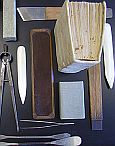We all have come across books that are in bad condition. Books that have suffered the consequences of exposure to one or more of the enemies of paper books, such as water, mold, smoke, dirt, direct sunlight, dust, insects, bad shelving and so forth. As any rare book collector should be familiar with, some of these problems can be prevented and even remedied depending on the specific situation, particularly in the case of the lower valued books. For any high valued books it may be worth seeking professional advice. With that in mind, let’s take a look at some of the book care supplies that every collector should not be left without.
Vacuum cleaner: Mold loves dust and dirt. Use a small handheld vacuum cleaner to surface clean the covers and textblocks at the lowest speed. Use a circular goat hair attachment to the vacuum for better sanction results.
Isopropyl alcohol: Never use water to clean and disinfect. Rubbing alcohol high in alcohol such as isopropyl alcohol evaporates quickly without the risk of being absorbed inside the pages. Use on books having laminated surfaces, modern dust jackets and other non-porous surfaces with an applicator such as a lint-free clean cloth. Never pour rubbing alcohol directly to the book.
Interleaving paper: In order to eliminate bad odor from a book, use interleaving paper that acts as an odor absorber. In cases of severe mold infestations it is a good idea to kill the fungi first by freezing the book in a plastic bag first. Inserting interleaving papers between the leaves of the book is the easiest and safest way to remove bad odors.
Organic solvents: Although the general approach should be to avoid solvents and abrasives when trying to clean leather bound volumes, there are times when you do need to clean substances such as oil spew on a leather binding. Your best option is to use an organic solvent.
Leather protectors/restorers: Be very careful with the application of some of the commercially available leather cleaning and restoring products since they have the tendency to change the leather’s original color. Look for products that contain silicon or petroleum or cellulose ethers that stabilize without discoloring.
Chemical Sponges: The best way to remove dirt from textblocks is with the use of chemical sponges. Hold the pages of the book tight in one hand with covers open and brush the textblock with a chemical sponge outward in the same direction. They are much better than using fine sand paper to do the job.
Erasers: Avoid using eraser pads or plastic, hard erasers that may abrade paper, and never use erasers on leather bindings. Art gum soft erasers are useful in erasing pencil marks and light stains.
Mylar coverings: Mylar or melinex is the transparent plastic that is used to protect primarily dust jackets since they are easily torn or chipped. They can also be used to cover paper and leather bindings against ultra-violet rays, dirty fingers and even water.
Corrugated boxes: Light weight, chemically stable corrugated board boxes are ideal for storing books that are destined for long-term isolation. The air circulating in the flutes of the corrugated structure offer insulation and provide excellent protection against temperature variations and top or side pressure resistance.
There are a large number of conservation suppliers of materials such as the ones described above. In a future article we will list some of the best products available that we are using and have good experiences to share. In the meantime, try to rotate the location of your books while keeping them upright to protect their spines, size permitting, and avoid extreme heat or humidity. Keep them away from ultra-violet light in a room that is humidified in the winter and dehumidified in the summer.
Photo – Julie Martin, NEDCC

{ 1 comment… read it below or add one }
Hi. I have a lovely cloth bound book from 1910, probably worth about £50. Unfortunately it was left in the shed for a couple of years and the mice got at it. It’s slightly soiled from urine and some cloth bitten away. Thankfully, the interior pages seem fairly untouched. Is there a safe way to clean and restore it.? Many thanks, Jilly
{ 4 trackbacks }